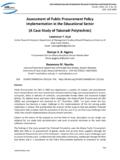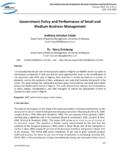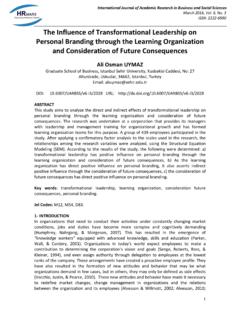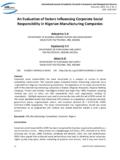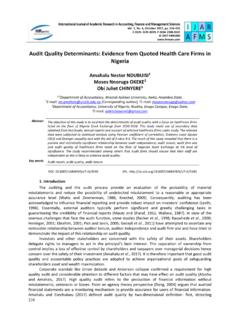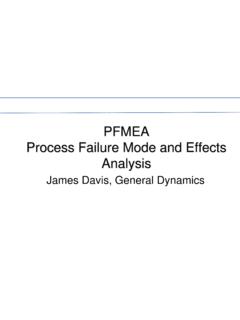Transcription of Organizational Conflicts: Causes, Effects and …
1 International Journal of Academic Research in Economics and Management Sciences Nov 2014, Vol. 3, No. 6. ISSN: 2226-3624. Organizational conflicts : causes , Effects and Remedies Bernard Oladosu Omisore, Centre for Management Development, Shangisha, Lagos, Nigeria E-mail: (Mrs) Ashimi Rashidat Abiodun RM, RN, ONC, BNsc, MPA. Federal Medical Centre, Idi-Aba, Abeokuta, Nigeria DOI: URL: Abstract This paper examines the causes , Effects and remedies of Organizational conflict. What are the things that lead to conflicts in organizations? The study found out that like other terms, conflict generates considerable ambivalence and leaves many scholars and administrators quite uncertain about (1) its meaning and relevance; and (2) how best to cope with it.
2 conflicts are inevitable in human life. It is also inevitable in organizations or even between nations. Conflict is an inseparable aspect of people's as well as organizations' life. The study also discovered that conflicts occur in organizations as a result of competition for supremacy, leadership style, scarcity of common resources, etc. If a conflict is not well and timely managed, it can lead to low productivity or service delivery. The study also discovered that conflict can sometimes produce positive result, if well managed. Thus, not all conflict situations are bad.
3 Efforts should always be made to ensure that the causes of conflicts are addressed as soon as they are noticed. The paper concludes that early recognition and paying attention to the conflicting parties and negotiation between parties involved in the conflict should be adopted in resolving conflicts while force or intimidation should never be used to resolve conflicting parties. Force and intimidation can only be counter productive. KEY WORDS: causes , Effects , Remedies, Organizational , Conflict, Concept. Introduction The concept of conflict, because of its ubiquity and pervasive nature, has acquired a multitude of meanings and connotations, presenting us with nothing short of semantic jungle.
4 Like other terms, conflict generates considerable ambivalence and leaves many scholars' and administrators quite uncertain about (1) its meaning and relevance; and (2) how best to cope with it. Conflict situations are inevitable in one's personal life, in organizations or even between nations. Conflict is a process in which one party suggests that its interests are being opposed by another party. As a rule, people see only the observable aspect of conflict angry words, actions of opposition, etc. But this is only a small part of the conflict process (Mashanne and Glinow, 2008).
5 118 International Journal of Academic Research in Economics and Management Sciences Nov 2014, Vol. 3, No. 6. ISSN: 2226-3624. Conflict is an inseparable part of people's life. It is a perpetual gift of life, although varying views of it may be held. Some may view conflict as a negative situation which must be avoided at any cost. Others may see it as a phenomenon which necessitates management. Still, others may consider conflict as an exciting opportunity for personal growth and so try to use it to their best advantage. Wherever one may fall on this continuum of view points concerning conflict, seldom would one expect to be in a continual state of conflict as the basis for employment (Nebgen, 1978).
6 Conflict theory is significant to the role of the administrator, but it emanates primarily from fields such as business, sociology, psychology, etc. According to Coser (1967), conflict is a struggle over values and claims to scarce status, power and resources in which the aims of the opponents are to neutralize, injure or eliminate the rivals. It is also defined from communication perspective as an expressed struggle between at least two interdependent parties who perceive incompatible goals, scarce rewards and interference from other parties in achieving their goals (Hocker and Wilmot, 1985).
7 According to Wikipedia, Organizational conflict is a state of discord caused by the actual or perceived opposition of needs, values and interests between formal authority and power and those individuals and groups affected. There are disputes over how revenues should be divided, and how long and hard people should work. There are jurisdictional disagreements among individual departments and between unions and management. There are subtle forms of conflict involving rivalries, jealousies, personality clashes, role-definitions and struggles for power and favour. There is also conflict within individuals between competing needs and demands to which individuals respond in different ways.
8 Since conflict is seemingly unavoidable, it is obviously necessary for managers to be able to recognize the source of the conflict, to view it's constructive as well as destructive potential, to learn how to manage conflict and to implement conflict resolution technique in a practical way (Fleerwood, 1987). However, in the last 25 years, many scholars have changed their views concerning conflict. Conflict is now seen as having the potential for positive growth. Deetz and Stevenson (1986), list three assumptions that indicate that conflict can be positive. Their belief is that management of conflict serves as a more useful conception of the process of conflict resolution.
9 Their assumptions are as follows: (a) conflict is natural;. (b) conflict is good and necessary; and (c) most conflicts are based on real differences. That conflict is good and necessary is suggested because conflict can stimulate innovative thinking when properly managed. Lacking conflicts , thought and action are performed because they are habitual. conflicts allow an examination of necessity of these thoughts and actions. The third assumption points out that people are frequently timid in facing the reality that legitimated differences may exist and instead blame conflict on poor or non-existent communication.
10 It may seem easier to live with unresolved misunderstanding than to face the fact that real, fundamental differences do exist and so demand recognition and management (Deetz and Stevenson, 1986). However, conflict in organizations is a daily occurrence because a consensus of opinion concerning rules governing the organization seldom exists among staff and line employees. 119 International Journal of Academic Research in Economics and Management Sciences Nov 2014, Vol. 3, No. 6. ISSN: 2226-3624. They see one another as adversaries, and not as partners working towards a common goal as the case should be in the organization.
